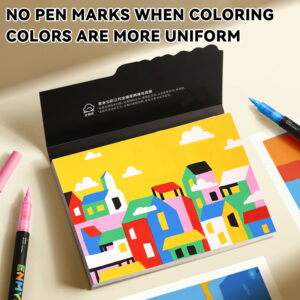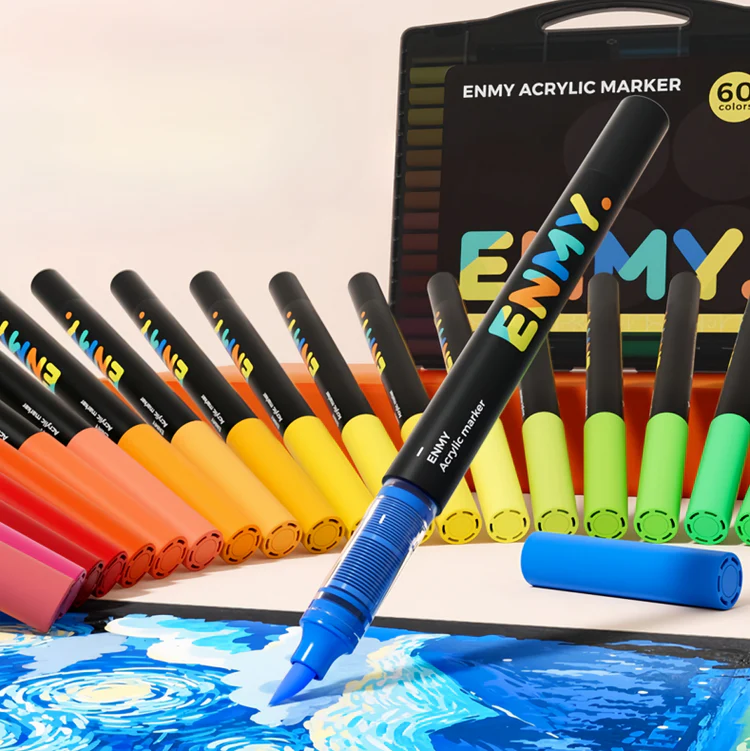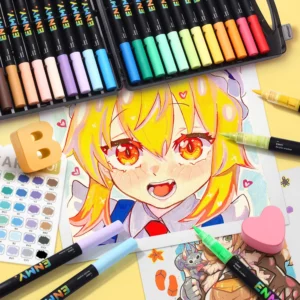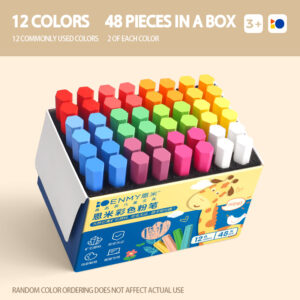Children’s art supplies are not just tools for creation; they are magic wands that inspire imagination and creativity. This article will detail the types of children’s art supplies and key points for selection, helping you open the door to art for your child.

-
Watercolor Paints: Watercolor paints are like agile little elves, highly water-soluble, easily blending with water to create fresh, transparent, and vivid effects, as if bringing a dream world to life on paper. They are an excellent choice for children just starting their painting journey, as they are easy to use and clean, without causing too much trouble for parents. When using watercolors, children can create rich color gradients and unique blooming effects by controlling the amount of water, fully exerting their creativity and imagination.
-
Acrylic Paints: Acrylic paints are like vibrant little suns, with bright, dazzling colors that shine like sunlight. Once dry, they have excellent water resistance, keeping the painting’s colors vivid for a long time. However, using acrylic paints requires children to master certain skills, such as controlling the thickness of the paint and the strength of application. It is these challenges that allow children to continuously improve their painting skills during the process.
-
Colored Pencils: Colored pencils are like delicate threads, with rich and varied colors, capable of depicting extremely detailed images. Children can use them to carefully outline the contours of objects and subtly express the texture and light changes of objects. For children who enjoy depicting details in depth and pursuing exquisite images, colored pencils are undoubtedly their right-hand man.
-
Crayons: Crayons are like warm little flames, soft in texture and easy to handle. Especially for younger children, the thick and fat bodies of crayons are easier for them to hold, and they glide smoothly on paper when applied. Children can use crayons to doodle boldly and freely express their inner thoughts and feelings. Moreover, the rich colors of crayons can fully stimulate children’s imagination, allowing them to roam freely in the world of painting.
The choice of drawing paper is equally crucial; different papers are like different stages, providing a space for various art supplies to showcase their charm.
-
Watercolor Paper: Watercolor paper is like a dreamy stage specially created for watercolor paints. It is thick in texture and highly absorbent, perfectly capable of carrying the flow and blooming of watercolor paints, making the effect of watercolor paintings even more outstanding. When painting on watercolor paper, children can feel the wonderful process of the paint spreading naturally on the paper, creating artistic works.
-
Sketch Paper: Sketch paper is an exclusive stage for sketch lovers. Its surface is relatively rough, which can better absorb the strokes of pencils and charcoal, making the lines clearer and smoother. Whether gently outlining contours with a pencil or boldly expressing light and shadow contrasts with charcoal, sketch paper can provide strong support for children’s sketch creation.
Markers are like colorful rainbows, with bright and vivid colors and extremely fast drying speed, as if making the picture vivid in the blink of an eye. They are very suitable for making dynamic posters and creative illustrations. Markers have unique strokes, and children can create various interesting textures and effects through different stroke applications, adding unique charm to their works.
Craft materials open a new door for children’s creation, allowing them to perfectly combine painting with handicrafts to create unique works.
-
Scissors: Scissors are like magical magic scissors. Children can use them to cut paper into various shapes, such as cute little animals, beautiful flowers, etc., adding rich elements to their works. In the process of using scissors, children’s fine motor skills and spatial cognitive abilities can also be effectively exercised.
-
Glue: Glue is like a magical adhesive, which can skillfully combine various materials, allowing children’s creativity to be realized. Whether pasting colored paper, small ornaments, or splicing cut shapes into a complete picture, glue plays an indispensable role.
-
Colored Paper: Colored paper has colorful colors, as if it is a fragment of a rainbow, providing a rich color choice for children’s creation. Children can fold, cut, and paste colored paper to make various handicrafts, such as paper flowers, three-dimensional greeting cards, etc.
-
Cotton: Cotton gives people a soft and warm feeling. It can be used to make clouds, snowflakes, etc., adding vivid texture to the work. Children can paste cotton on the drawing paper and then decorate it with colored pens to create a dreamy atmosphere.
Children’s health is the top concern of parents, so safety must be the first priority when selecting art supplies. Ensure that the selected art supplies are non-toxic and harmless, and resolutely avoid products containing heavy metals, harmful chemicals, or pungent odors. When purchasing art supplies, carefully check whether the product packaging is marked with a “non-toxic” label, and pay attention to the product’s safety certifications, such as ASTM D-4236 or EN71 standards. These certification marks are like putting a “safety helmet” on the art supplies, indicating that the product meets the safety standards for children’s use, allowing parents to buy with confidence. For example, when choosing watercolor paints, prioritize brands that have passed authoritative safety testing and have a good reputation to ensure that children will not be exposed to harmful substances during the painting process.
Selecting art supplies according to the child’s age and painting level is like choosing a pair of suitable shoes for the child, enabling them to walk more easily and happily on the road of painting. For younger children (generally 3-5 years old) with underdeveloped hand control ability, choose art supplies that are easy to handle, such as thick crayons, non-toxic watercolor pens, and water-soluble markers. These art supplies have thick bodies, are easy for children to hold, and are simple to operate, helping them easily leave colors on paper and build interest and confidence in painting. For older children (over 6 years old) who have certain painting foundations and fine motor skills, more detailed and challenging painting tools, such as oil pastels and colored pencils, can be considered. These art supplies allow children to better express details and color gradients, further improving their painting skills. For example, a thick crayon can let a 3-year-old child who has just started doodling enjoy the fun of painting; while a set of high-quality colored pencils can meet the needs of an 8-year-old child who has a high interest in painting and certain skills for in-depth creation.
High-quality art supplies are like a caring partner, providing children with a better user experience and allowing them to fully feel the joy of creation during the painting process. When choosing art supplies, pay attention to their quality, such as the color saturation and gloss of pigments, and the smoothness of brushes. High-quality pigments have bright and pure colors, making children’s works more vivid and attractive; while brushes write or paint smoothly without jamming or ink breaking, allowing children to express their ideas more smoothly. For example, when choosing watercolor paints, observe the performance of the paint in the palette. Paints with bright colors, easy to mix, and even application are often of better quality; when selecting brushes, try drawing on paper to feel the hand feel and water output, and choose brushes with comfortable hand feel and smooth water output.
Considering that children may be more “active” when using art supplies, the durability of art supplies is also an important factor in selection. Choosing art supplies that are not easy to damage and can withstand repeated use by children can reduce the trouble of frequent purchases, and also allow children to create more freely without worrying about sudden damage to the art supplies. For example, choosing wear-resistant colored pencils with cores that are not easy to break allows children to focus more on painting; water-resistant acrylic paints do not fade easily after drying, allowing children’s works to be preserved for a long time.
To fully stimulate children’s creativity and imagination, it is advisable to provide them with a variety of painting materials, allowing them to explore and try in different painting media. Every child is unique, and they may have different preferences and talents for different art supplies. By trying various art supplies, children can find their favorite painting methods, thereby further exploring their artistic potential. For example, prepare a painting set containing watercolors, oil pastels, colored pencils, crayons, and other art supplies for children, allowing them to choose suitable art supplies according to their preferences and creativity during free creation, and enjoy the fun of diversified painting.
At this stage, children are in a period of rapid development of hand-eye coordination and shape cognition, and painting is more of a way for them to express and explore freely.
-
Recommended Tools
- Thick Crayons: Thick crayons have thick bodies, very suitable for children’s tender little hands to grasp. Their soft texture and rich colors allow children to easily apply various shapes on paper, stimulating their interest in painting. Moreover, crayons are non-toxic and odorless, so parents don’t have to worry about safety even if children accidentally get the paint on their hands or faces.
- Finger Paints: Finger paints bring children a new painting experience. They can directly dip their fingers in the paint and freely apply and press on the paper, feeling the wonderful feeling of the paint flowing at their fingertips. This painting method can give full play to children’s imagination and also help exercise their hand touch and perception ability. Finger paints usually have good water solubility and are very easy to clean, so parents don’t have to worry about cleaning the paint on their children.
-
Creation Themes
- Animal Outline Tracing: Children can use thick crayons to trace along simple animal outlines, which can not only help them recognize the shapes of various animals but also exercise hand-eye coordination. On the basis of tracing, children can also use their imagination to color the animals, making them more vivid and interesting.
- Geometric Figure Coloring: Provide some patterns composed of simple geometric figures and let children color them with crayons or finger paints. Through this process, children can recognize different geometric figures, such as circles, triangles, squares, etc., and also cultivate their perception and application ability of colors.
At this stage, children’s fine motor skills have further developed, and their interest in painting is more intense, starting to try to express their ideas and feelings through painting.
-
Recommended Tools
- 12-color Watercolor Set: A 12-color watercolor set can provide children with a rich color choice, meeting their basic needs in the painting process. The transparent characteristics and rich color gradients of watercolor paints can make children feel the charm of painting, and learning to use watercolor paints also helps to cultivate their sensitivity and control ability to colors.
- Colorful Oil Pastels: Colorful oil pastels have bright colors and delicate textures, which are easy to color and can create unique effects through color mixing and scratch painting techniques. Children can use oil pastels to draw colorful and dynamic works, giving full play to their creativity and imagination.
-
Creation Themes
- Seasonal Landscape Painting: Guide children to observe the characteristics of different seasons’ scenery, such as spring flowers, summer green trees, autumn fallen leaves, winter snowflakes, etc., and then depict the seasonal scenery they see with a 12-color watercolor set or colorful oil pastels. This process can not only improve children’s painting skills but also cultivate their observation and perception of nature.
- Story Scene Reproduction: Children usually like listening to stories. Let them reproduce a scene in their favorite story through painting. This can exercise children’s imagination and creativity, and also help improve their narrative ability and performance ability of details. In the painting process, children can use oil pastels to draw the main characters and scenes, and use watercolor paints to render the atmosphere, making the work more vivid and interesting.
-
Usage Methods of Painting Tools: Before children start using new painting tools, parents can demonstrate the correct usage methods to them. For example, how to hold the pen correctly, how to control the amount of paint, how to use different parts of the brush to show different effects, etc. Let children develop good painting habits in the process of learning to use art supplies.
-
Storage and Arrangement of Art Supplies: Helping children develop the good habit of storing and arranging art supplies can not only keep the environment clean but also extend the service life of art supplies. Prepare a special storage box or shelf for children’s art supplies, so that they can classify and arrange brushes, pigments, drawing paper, etc., and put them back in place after each use. In this way, children can quickly find the art supplies they need next time, and at the same time, cultivate their self-care ability and sense of responsibility.
-
Cleaning Methods for Different Art Supplies: Different art supplies need different cleaning methods after use. For example, watercolor paints and water-soluble markers can be directly cleaned with water; crayon stains can be wiped with olive oil or alcohol; colored pencil marks can be gently wiped off with a damp cloth. Parents should tell their children to try to avoid getting paint on clothes or other items during painting, and if they accidentally get dirty, clean them in time according to the correct method.
-
Regularly Check the Status of Art Supplies: Regularly check children’s art supplies to see if the pigments have deteriorated, if the brushes are damaged, etc. For art supplies that have expired or cannot be used, replace them in time to ensure that children can use high-quality art supplies when painting. For example, if watercolor paints dry out and agglomerate, it will affect the painting effect, and new paints need to be purchased in time; if brushes have bristle loss, tip damage, etc., they also need to be replaced in time to avoid affecting children’s painting experience.
-
Provide Diversified Creation Themes: In addition to common painting themes, parents can try to provide children with some novel and interesting creation themes to inspire their creative inspiration. For example, let children create a painting based on a favorite song, or imagine themselves as a small animal and draw the world in their eyes. These unique themes can let children think and create from different angles, broadening their thinking ways.
-
Encourage Free Creation and Attempts: During children’s painting process, do not give them too many restrictions and guidance. Encourage them to give full play to their imagination and boldly try different art supplies and expression techniques. Every child has their own unique ideas and thoughts. Let them fully show their personality and talent in the process of free creation. Even if children’s works seem a little “strange” or not in line with the routine, do not easily deny them, but give affirmation and encouragement, so that children can feel that their efforts and creativity are recognized.
Children’s art supplies are the key to opening the door to art for children. Choosing suitable art supplies is of great significance for children’s painting creation and growth. It is hoped that through the introduction of this article, parents can better understand the types and selection methods of children’s art supplies, select the most suitable art supplies for their children, let children soar freely in the world of painting, and depict their own wonderful childhood with brushes.




